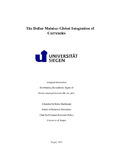Citation link:
https://nbn-resolving.org/urn:nbn:de:hbz:467-14681Files in This Item:
| File | Description | Size | Format | |
|---|---|---|---|---|
| Dissertation_Helen_Ghebrezghi.pdf | 2.09 MB | Adobe PDF |  View/Open |
| Dokument Type: | Doctoral Thesis | metadata.dc.title: | The dollar malaise: global integration of currencies | Authors: | Ghebrezghi, Helen | Institute: | Fakultät III Wirtschaftswissenschaften, Wirtschaftsinformatik und Wirtschaftsrecht | Free keywords: | Monetary Policy, Central Bank, Econometrics | Dewey Decimal Classification: | 330 Wirtschaft | GHBS-Clases: | PQM | Issue Date: | 2018 | Publish Date: | 2019 | Abstract: | The global financial crisis, which had its centre-point in the United States, raised speculation about the US dollar’s imminent displacement as the world’s largest international currency. Many scholars and financial analysts were predicting the end of the US dollar’s dominant role in the international monetary system. Krugman (2007), for example, wrote that "almost everyone believes that the US current account deficit must eventually end, and that this end will involve dollar depreciation (p.1)". The World Bank and the International Monetary Fund also predicted a decline in the US dollar’s value and the consequences this would inevitably have for the global economy. But these analysts, at least for now, have been proven wrong, since the opposite has happened. During the height of the crisis, money was flowing back into the United States, and foreign investors, who were searching for a safe-haven currency for their money, added to the inflow. After the dollar dethroned the British pound – be it after World War II, as some scholars argue, or as early as the 1920s – the US dollar has been the world’s leading global currency. The end of the gold standard in 1973 did not upset the dollar’s role within the international monetary system, but the growing gap of the US economy and financial markets compared to other economies enhanced the dollar’s status as the most powerful currency in the world. The question whether the dollar is losing its international role first emerged seriously in the 1990s, when the Deutsche Mark and Japanese Yen had made increasing gains during the 1970s and 1980s. The strong German and Japanese economies, low inflation, and a current surplus suggested that the US dollar might be dethroned. But this event did not occur. The introduction of the Euro in 1999 was the first serious competitor to the dollar in the post-war era. The European Monetary Union has been a fusion of Europe’s economic power, and its influence in the global economy can challenge the US economy and consequently the role of the US dollar. But the European Sovereign Debt Crisis has challenged the Eurozone, and so far the Euro is lagging behind the US dollar. This dissertation stands as a reflection of my broad interest in the monetary policy of developing countries. There is a wide body of literature that covers different aspects of this field of study, but the list of questions that have not been fully unanswered remains long. My thesis takes a different evolutionary course to contribute to our understanding of the future structure of the international monetary system. While the three chapters address a range of different monetary policies and contexts, they are bound together by this common interest and by the way that they complement each other. The discussions and conclusion of this dissertation will give an updated framework for the future of the international monetary system. |
URN: | urn:nbn:de:hbz:467-14681 | URI: | https://dspace.ub.uni-siegen.de/handle/ubsi/1468 | License: | https://dspace.ub.uni-siegen.de/static/license.txt |
| Appears in Collections: | Hochschulschriften |
This item is protected by original copyright |
Page view(s)
609
checked on Nov 25, 2024
Download(s)
594
checked on Nov 25, 2024
Google ScholarTM
Check
Items in DSpace are protected by copyright, with all rights reserved, unless otherwise indicated.

